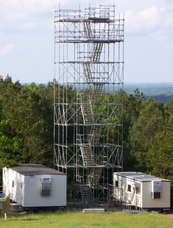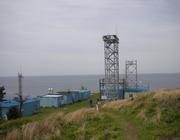
The Tropospheric Oxidation Capacity Research Group
Biosphere-Atmosphere-Human Interactions
3216 Croul Hall Irvine CA 92627 (email)

Atmospheric chemistry of an Antarctic volcanic plume
Journal:
Journal of Geophysical Research-AtmospheresVolume Number:
115Abstract:
We report measurements of the atmospheric plume emitted by Erebus volcano, Antarctica, renowned for its persistent lava lake. The observations were made in December 2005 both at source, with an infrared spectrometer sited on the crater rim, and up to 56 km downwind, using a Twin Otter aircraft; with the two different measurement platforms, plume ages were sampled ranging from <1 min to as long as 9 h. Three species (CO, carbonyl sulfide (OCS), and SO(2)) were measured from both air and ground. While CO and OCS were conserved in the plume, consistent with their long atmospheric lifetimes, the downwind measurements indicate a SO(2)/CO ratio about 20% of that observed at the crater rim, suggesting rapid chemical conversion of SO(2). The aircraft measurements also identify volcanogenic H(2)SO(4), HNO(3) and, recognized for the first time in a volcanic plume, HO(2)NO(2). We did not find NO(x) in the downwind plume despite previous detection of NO(2) above the crater. This suggests that near-source NO(x) was quickly oxidized to HNO(3) and HO(2)NO(2), and probably NO(3(aq))(2-), possibly in tandem with the conversion of SO(2) to sulfate. These fast processes may have been facilitated by "cloud processing" in the dense plume immediately downwind from the crater. A further striking observation was O(3) depletion of up to similar to 35% in parts of the downwind plume. This is likely to be due to the presence of reactive halogens (BrO and ClO) formed through heterogeneous processes in the young plume. Our analysis adds to the growing evidence for the tropospheric reactivity of volcanic plumes and shows that Erebus volcano has a significant impact on Antarctic atmospheric chemistry, at least locally in the Southern Ross Sea area.
Notes:
Times Cited: 15
Related External URL:
<Go to ISI>://WOS:000275036600002- Citation:
- Oppenheimer, C, Kyle P, Eisele F, Crawford J, Huey G, Tanner D, Kim S, Mauldin L, Blake D, Beyersdorf A et al.. 2010. Atmospheric chemistry of an Antarctic volcanic plume. Journal of Geophysical Research-Atmospheres. 115

